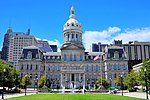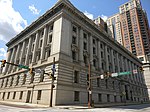The Baltimore City Circuit Courthouses are state judicial facilities located in downtown Baltimore, Maryland. They face each other in the 100 block of North Calvert Street, between East Lexington Street on the north and East Fayette Street on the south across from the Battle Monument Square (1815-1822), which held the original site of the first colonial era courthouse for Baltimore County (third county courthouse after previous locations / county seats in old Baltimore village on the Bush River and later Joppa) and Town, after moving the Baltimore County seat in 1767 to the burgeoning port town on the Patapsco River established in 1729-1730.
The first courthouse in Baltimore Town was built in 1767 and also later housed briefly for a decade the new United States federal courts in the city, after the ratification and operation of the new Constitution in 1789. On July 28, 1776, it was the site for the public reading of the Declaration of Independence, just previously approved by the Second Continental Congress on behalf of the Thirteen Colonies, now United States of America, meeting at the old Pennsylvania State House (now Independence Hall) three weeks earlier in Philadelphia and read out loud to a gathering of Baltimore Town citizens. It was undercut in 1784 by local builder/contractor Leonard Harbaugh with a pair of arched stone/brick arched piers and raised stone foundation to permit extension of Calvert Street to the north by passing traffic underneath at a lower level. This town/county courts structure was torn down around 1800, leaving an empty small square for fifteen years.A second city/county courthouse of Georgian and Federal style architecture in red brick and limestone trim with a cupola was constructed to the west of old Courthouse Square (later renamed Battle Monument Square in honor of the monument raised for remembering local casualties from the British attack in September 1814 during the Battle of Baltimore during the War of 1812). It was sited on the southwest corner of North Calvert and facing north towards East Lexington Street, completed in 1805. This second City/County Courthouse (which also served the small federal district court and judges chambers for 15 years until 1820, when they were relocated into one wing of the huge massive H-shaped Merchants Exchange building capped with a low dome at South Gay and East Lombard Streets, designed and completed that year by famous British-American architect Benjamin Latrobe) was partially burned on 13 February 1835 during a spate of mysterious arson fires in the city during the bank riots that year, but it was soon repaired. An adjacent Egyptian style masonry building to the west along Saint Paul Street was constructed for a Records Office. It was razed around 1896 along with the other structures on the block to its south and west.A third and current courthouse, was built 1896–1900, on the entire city block west of the 1815-1822 Battle Monument. It is bounded by North Calvert Street on the east, East Lexington Street on the north, East Fayette Street on the south and St. Paul Street on the west.
A small federal district courthouse and United States Post Office of white marble and limestone was constructed on the northwest corner of East Fayette and North Street (later renamed Guilford Avenue) in 1860 for the federal offices relocated from the one wing of the 1820 Merchants Exchange and was dedicated by 15th President James Buchanan and served only 29 years until 1889.
Then it was replaced by a much larger structure with a clock tower and eight massive chimneys facing to the west on Calvert Street and the Battle Monument, occupying the rest of the entire block between Calvert, Lexington, North (Guilford) and Fayette Streets.
That Federal courts and central city Post Office on Calvert Street was replaced after only forty years of use in 1932, during the administration of 31st President Herbert C. Hoover which served for the next four decades until replaced by the current Edward A. Garmatz U.S. Courthouse at West Lombard and South Hanover / Liberty Street/Hopkins Place structure adjacent to the 1960s era Charles Center downtown redevelopment project. The old Hoover era federal courts and post office was then transferred to the city by the federal government in 1977 for its use and renovated with being renamed Courthouse East. Today the two historic main structures of the Maryland state judicial system in the City of Baltimore are the Clarence M. Mitchell Jr. Courthouse of 1896-1900 and Elijah E. Cummings Courthouse (the former Baltimore Post Office and U.S. Courthouse of 1932).
Together they house the 30 judges of the 8th Judicial Circuit for the State of Maryland (Circuit Court of Maryland for Baltimore City). In addition to the criminal, civil and family (formerly orphans court) courts, these two courthouses also contain the Office of the State's Attorney for Baltimore City, the Clerk of the Circuit Court, the historic Baltimore City Bar Law Library, the City Sheriff's Office, the recently established Baltimore Courthouse and Law Museum (in the former Orphans Court chambers), the Pretrial Release Division of the Maryland Department of Public Safety and Correctional Services, several pretrial detention lockups, jury assembly rooms, land records, court medical offices and Masters hearing rooms.












